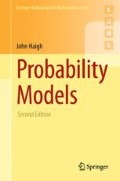Summary
If you throw a fair die, with no clues given about the outcome, the chance of getting a six is 1/6. But maybe you have been told that this blue die, and another red die were thrown, and their total score was four. Then you could be sure that the score on the blue die was not six. Similarly, to be told that the total score was ten makes it more likely that the blue die scored six, as all scores lower than four are eliminated. Information about the total score on the two dice can change your original opinion about the chance of a six.
Access this chapter
Tax calculation will be finalised at checkout
Purchases are for personal use only
Bibliography
Simpson EH (1951) The interpretation of interaction in contingency tables. J R Stat Soc B 13:238–241
Author information
Authors and Affiliations
Rights and permissions
Copyright information
© 2013 Springer-Verlag London
About this chapter
Cite this chapter
Haigh, J. (2013). Conditional Probability and Independence. In: Probability Models. Springer Undergraduate Mathematics Series. Springer, London. https://doi.org/10.1007/978-1-4471-5343-6_2
Download citation
DOI: https://doi.org/10.1007/978-1-4471-5343-6_2
Publisher Name: Springer, London
Print ISBN: 978-1-4471-5342-9
Online ISBN: 978-1-4471-5343-6
eBook Packages: Mathematics and StatisticsMathematics and Statistics (R0)

